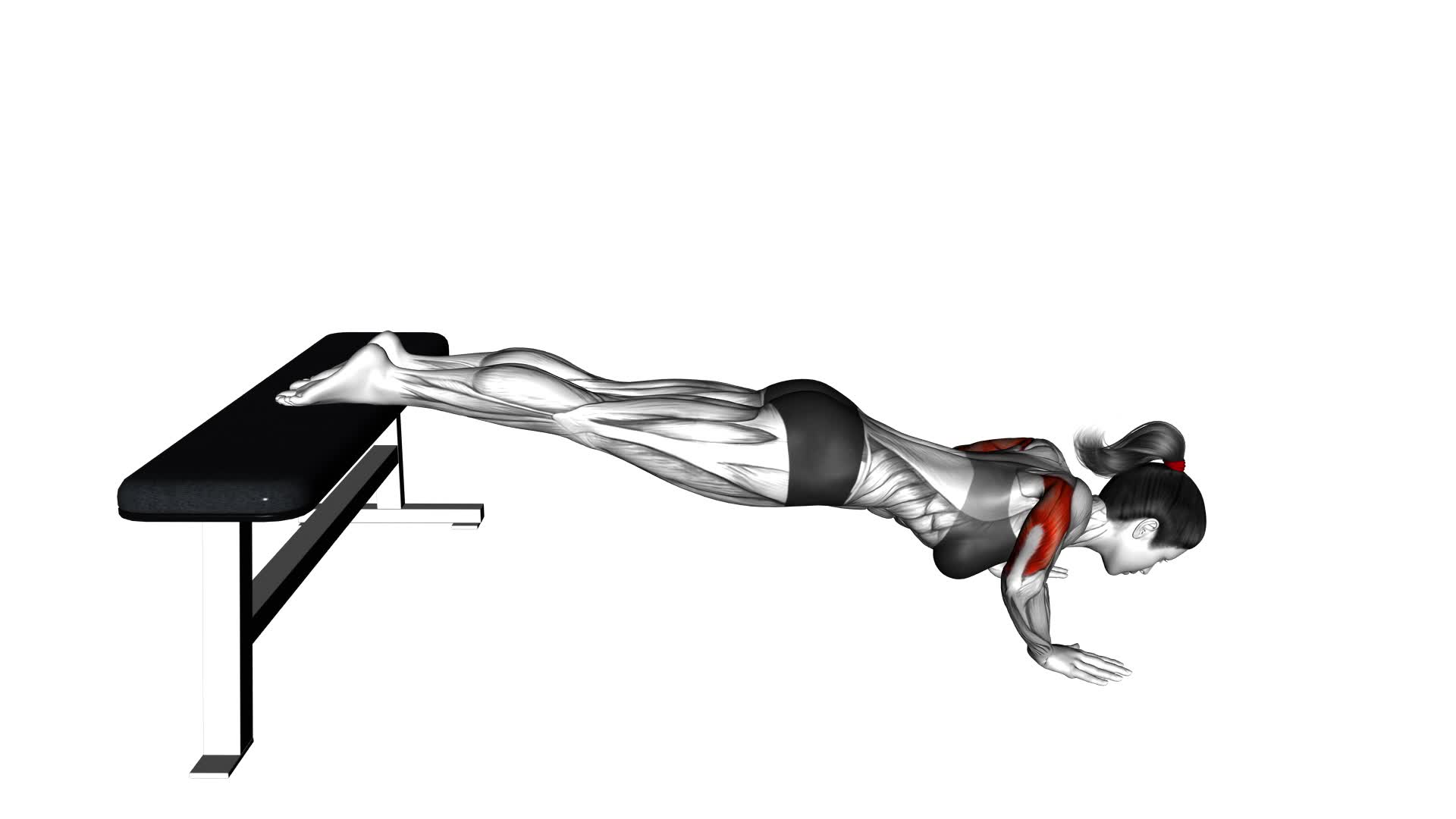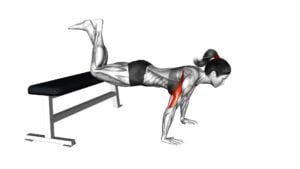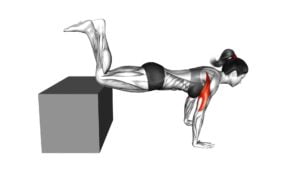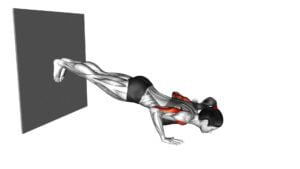Decline Push-up (female) – Video Exercise Guide & Tips

Are you looking to take your push-up game to the next level?
Watch This Exercise Video
In this video exercise guide, we'll show you how to perform the decline push-up with proper form and technique.
Not only will you learn the benefits of this challenging variation, but we'll also provide modifications for beginners and advanced variations for seasoned athletes.
Get ready to maximize your workout and achieve your fitness goals with these tips and techniques.
Let's get started!
Key Takeaways
- Proper form and technique are essential for maximizing effectiveness and minimizing the risk of injury.
- The decline push-up increases upper body strength, improves core stability, and engages multiple muscle groups.
- Beginners can modify the exercise by starting with incline push-ups, knee push-ups, wall push-ups, or using resistance bands.
- Advanced athletes can try variations like single leg decline push-ups, decline spiderman push-ups, or incorporating weighted vests or unstable surfaces for added challenge.
Proper Form and Technique
To perform a decline push-up correctly, you should position your hands slightly wider than shoulder-width apart on an elevated surface such as a bench or step. This proper form and technique is crucial to avoid common mistakes and injuries.
One common mistake is having your hands too close together, which puts excessive strain on your wrists and shoulders. By positioning your hands wider, you distribute the weight more evenly and engage multiple muscle groups.
Another common mistake is allowing your back to sag or your hips to drop, which can lead to lower back pain or strain. To prevent this, engage your core muscles and maintain a straight line from your head to your heels throughout the movement.
It's important to note that the decline push-up is an advanced exercise, so it's essential to listen to your body and progress gradually. Proper form and technique not only maximize the effectiveness of the exercise but also minimize the risk of common injuries.
Benefits of the Decline Push-up
You can experience several benefits from incorporating the decline push-up into your workout routine. This exercise is a great way to increase your upper body strength and improve your core stability. By performing the decline push-up, you engage your chest, shoulders, triceps, and core muscles, helping you to build strength and definition in these areas.
One of the main benefits of the decline push-up is the increased upper body strength it provides. As you lower your body towards the ground and push back up, your chest and triceps muscles are working hard to move your body weight. This constant resistance helps to build strength and muscle endurance in your upper body.
Additionally, the decline push-up is an effective exercise for improving core stability. As you perform the exercise on an inclined surface, your core muscles engage to maintain stability and control throughout the movement. This not only helps to strengthen your abs, but also improves your overall balance and coordination.
Incorporating decline push-ups into your workout routine can have a significant impact on your overall strength and fitness level. By consistently performing this exercise, you'll notice increased upper body strength and improved core stability, helping you to excel in other exercises and daily activities.
Modifications for Beginners
If you're new to the decline push-up, there are several modification options you can try to make the exercise more accessible. These modifications can help you build strength and gradually work your way up to the full exercise. Here are some common mistakes to avoid and modification options to consider:
- Start with an incline push-up: Place your hands on an elevated surface, such as a bench or step, and perform push-ups from that position. This reduces the amount of weight you have to lift and makes the exercise easier.
- Use knee push-ups: Instead of performing the push-up on your toes, drop to your knees and keep your body in a straight line as you lower and lift yourself. This modification decreases the amount of resistance and allows you to focus on mastering the movement.
- Try wall push-ups: Stand facing a wall and place your hands on the wall at shoulder height. Lean forward and push yourself away from the wall, then back towards it. This modification is great for beginners or those with limited upper body strength.
- Utilize resistance bands: Loop a resistance band around your back and hold onto the handles. As you lower yourself down, the band will provide assistance and make the exercise easier. Gradually decrease the assistance as you get stronger.
Advanced Variations for Seasoned Athletes
Take your decline push-up to the next level with these challenging variations for seasoned athletes. As an advanced athlete, you're always looking for ways to push your limits and continuously improve your strength and endurance. These advanced modifications won't only increase the intensity of your decline push-ups but also target different muscle groups, providing a well-rounded and challenging workout.
One advanced variation is the single leg decline push-up. By lifting one leg off the ground while performing the push-up, you're placing more weight and resistance on your upper body, particularly your chest, shoulders, and triceps. This modification engages your core and improves stability, making it an excellent choice for athletes looking to enhance their overall strength and balance.
Another advanced variation is the decline spiderman push-up. In this variation, as you lower your body towards the ground, you bring one knee up to your elbow, alternating sides with each repetition. This modification adds an extra challenge by incorporating a twisting motion and increasing the demands on your core and oblique muscles.
To further intensify your decline push-ups, you can try using a weighted vest or placing your feet on an unstable surface, such as a Bosu ball or a medicine ball. These intensity variations will challenge your stability and muscular endurance, taking your workout to the next level.
Tips for Maximizing Your Decline Push-up Workout
To get the most out of your decline push-up workout, it's essential to incorporate proper form and focus on engaging the targeted muscle groups. Here are some tips to help you maximize the intensity of your decline push-up workout and avoid common mistakes:
- Maintain a straight line from your head to your heels: Keep your core engaged and your body in a straight line throughout the exercise. This will ensure that you're working the muscles in your chest, shoulders, and triceps effectively.
- Lower your chest to a 90-degree angle: Aim to lower your chest until it's parallel to the ground. This will increase the range of motion and challenge your muscles even more.
- Squeeze your shoulder blades together: As you push up, focus on squeezing your shoulder blades together. This will help to activate your upper back muscles and improve your posture.
- Breathe properly: Remember to breathe throughout the exercise. Inhale as you lower your body and exhale as you push back up. This will provide your muscles with the oxygen they need to perform at their best.
By incorporating these tips into your decline push-up workout, you can maximize the intensity and effectiveness of the exercise. Avoiding common mistakes will help you achieve better results and avoid potential injuries.
Keep pushing yourself and stay committed to your fitness goals!
Frequently Asked Questions
How Many Calories Can I Burn by Doing Decline Push-Ups?
You can burn a significant number of calories by doing decline push-ups. This exercise not only helps you build upper body strength and tone your muscles but also increases your heart rate, leading to calorie burning.
The number of calories burned varies depending on factors like your weight, intensity, and duration of the exercise. Consistently incorporating decline push-ups into your workout routine can contribute to your overall calorie burning goals and help you achieve a toned physique.
Can Decline Push-Ups Help in Reducing Belly Fat?
Decline push-ups can be a helpful exercise to reduce belly fat. By targeting the muscles in your core and upper body, they can help strengthen and tone your abs.
To get the most out of decline push-ups, make sure to vary your hand placement and experiment with different angles. Remember to maintain proper form, with your body in a straight line and your core engaged.
Keep pushing yourself and you'll see results!
Are Decline Push-Ups Suitable for People With Wrist Pain?
If you're dealing with wrist pain, decline push-ups mightn't be suitable for you. However, there are alternative exercises that can help strengthen your upper body without putting strain on your wrists.
It's important to listen to your body and find exercises that work for you. While decline push-ups have their benefits, such as targeting your chest and shoulders, it's crucial to prioritize your wrist health and find exercises that won't exacerbate any pain or discomfort you may be experiencing.
How Often Should I Incorporate Decline Push-Ups Into My Workout Routine?
To effectively incorporate decline push-ups into your workout routine, it's important to consider both workout frequency and proper form.
Decline push-ups can be a challenging exercise that targets your chest, shoulders, and triceps.
To see results and avoid overtraining, aim to include decline push-ups in your routine 2-3 times a week.
Remember to maintain a straight body position, engage your core, and lower yourself with control to maximize the benefits of this exercise.
Keep pushing yourself and you'll see progress!
Can Decline Push-Ups Help in Improving Posture?
Decline push-ups can be a great exercise to improve posture. By challenging your upper body and core muscles, they help strengthen your back and shoulders, which are key for maintaining good posture.
Additionally, the decline position adds an extra element of balance, further engaging your muscles and improving stability.
So, if you want to work on your posture while increasing your upper body strength, incorporating decline push-ups into your routine is a smart choice.
Stay consistent and watch your posture improve!
Conclusion
Incorporating decline push-ups into your workout routine can provide numerous benefits. This exercise is great for building upper body strength and targets your chest, shoulders, and triceps. Whether you're a beginner or a seasoned athlete, there are modifications and advanced variations that can be tailored to your fitness level.
By following proper form and technique, you can maximize your results and achieve your fitness goals. Here are some tips to incorporate into your decline push-up workout:
- Start with a gradual decline: If you're new to decline push-ups, begin with a slight decline by placing your feet on a step or bench. As you build strength, you can gradually increase the decline to make the exercise more challenging.
- Maintain a straight line: When performing decline push-ups, it's important to keep your body in a straight line from head to toe. Avoid sagging your hips or lifting your butt too high. Engage your core muscles to maintain proper form.
- Control your descent: As you lower your body towards the ground, focus on controlling the movement and keeping your elbows slightly tucked in. This will engage your chest, shoulders, and triceps more effectively.
- Use a wider hand placement: To target your chest muscles more, try placing your hands wider than shoulder-width apart. This will shift the emphasis from your triceps to your chest.
Remember to listen to your body and take breaks if needed. Push yourself, but not to the point of pain or discomfort. With consistency and proper technique, you'll see improvements in your upper body strength and overall fitness.
So keep pushing and strive for greatness with the decline push-up!

Author
Years ago, the spark of my life’s passion ignited in my mind the moment I stepped into the local gym for the first time. The inaugural bead of perspiration, the initial endeavor, the very first surge of endorphins, and a sense of pride that washed over me post-workout marked the beginning of my deep-seated interest in strength sports, fitness, and sports nutrition. This very curiosity blossomed rapidly into a profound fascination, propelling me to earn a Master’s degree in Physical Education from the Academy of Physical Education in Krakow, followed by a Sports Manager diploma from the Jagiellonian University. My journey of growth led me to gain more specialized qualifications, such as being a certified personal trainer with a focus on sports dietetics, a lifeguard, and an instructor for wellness and corrective gymnastics. Theoretical knowledge paired seamlessly with practical experience, reinforcing my belief that the transformation of individuals under my guidance was also a reflection of my personal growth. This belief holds true even today. Each day, I strive to push the boundaries and explore new realms. These realms gently elevate me to greater heights. The unique combination of passion for my field and the continuous quest for growth fuels my drive to break new ground.







